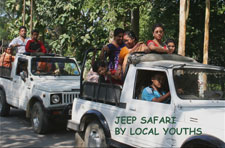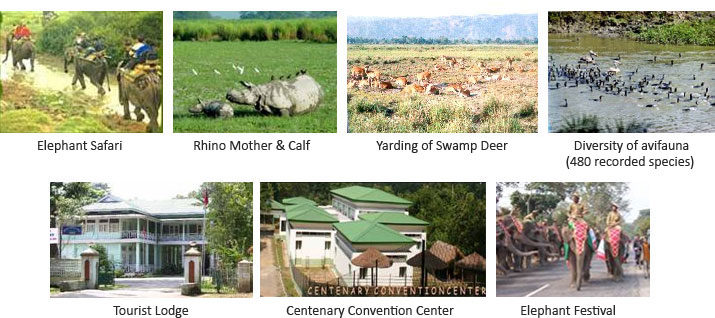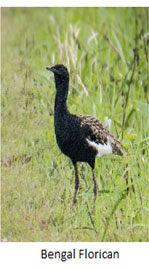 Attractions: Close look at Rhino, Swamp deer etc. on ‘Elephant Safari’ every morning. Sighting variety of wildlife by ‘Jeep Safari’, thousands of local and migratory birds flocking in wetlands and the scenic beauty of Karbi Anglong Hills.
Attractions: Close look at Rhino, Swamp deer etc. on ‘Elephant Safari’ every morning. Sighting variety of wildlife by ‘Jeep Safari’, thousands of local and migratory birds flocking in wetlands and the scenic beauty of Karbi Anglong Hills.
Significance: Largest undivided representative area of Brahmaputra valley flood plain grassland, complex eco-system of grassland, where various stages of biotic succession in grassland eco-system are explicit.
Mammals: The Park is the abode to more than 70% of One Horned Rhinoceros in the world. Highest density of tigers’ prey including the large prey biomass of tiger found in the country. Harbours more than 60% of India’s wild buffalo population along with the only population of the Eastern Swamp deer and seven species of turtles and tortoises. The other important wildlife found are - Leopard, Fishing Cat, other Lesser cats, Large Indian Civet, Small Indian Civet, Sambar, Barking deer, Hog deer, Gaur, Hog Badger, Hoolock Gibbon, Capped Langur, Assamese Macaque, Rhesus Macaque, Sloth Bear, Gangetic Dolphin and Otter etc.
Census figures of Big Five are - One horned Rhino - 1855 (2006), Swamp Deer - 468 (2000), Wild Buffalo - 1431 (2001), Tiger - 85 (2000), Elephant - 1246(2005).
 Birds: Home to 25 Globally Threatened and 21 Near Threatened species of birds. So far 480 bird species have been identified and recorded in the Park. The Baza, Bengal Florican, Hornbills, Osprey etc. are the endangered species. Presence of Pelicans and various waterfowls both resident and migratory etc.
Birds: Home to 25 Globally Threatened and 21 Near Threatened species of birds. So far 480 bird species have been identified and recorded in the Park. The Baza, Bengal Florican, Hornbills, Osprey etc. are the endangered species. Presence of Pelicans and various waterfowls both resident and migratory etc.
Aquatic Flora & Fauna: More than 150 perennial water bodies are located inside the Park, where water level fluctuates temporally resulting in the generation of a very rich aquatic floral diversity. More than 32 species of flora have so far been identified. More than 60 species of fishes have been recorded and is the breeding ground of many of the local species.
How to reach: Rowraiah (Jorhat) is the nearest Airport which is 97 Kms. away and LGBI Airport (Guwahati) is 239 Kms. away. The road distances from nearest cities & towns to Kohora are: from Jorhat is 89 Kms., from Nagaon is 96 Kms., from Guwahati is 219 Kms., from Golaghat is 73 Kms. and from Bokakhat is 21 Kms.
 Tourist Lodges & Resorts: Under Assam Tourism Department at Kohora - Bonani Lodge, Bonshree Lodge and Kunjaban Lodge, Tel.: (03776)262423 and under Assam Tourism Development Corporation - Aranya Lodge and Prasanti Cottages, Tel.: (03776)262429.
Tourist Lodges & Resorts: Under Assam Tourism Department at Kohora - Bonani Lodge, Bonshree Lodge and Kunjaban Lodge, Tel.: (03776)262423 and under Assam Tourism Development Corporation - Aranya Lodge and Prasanti Cottages, Tel.: (03776)262429.
Private Lodges: Wildgrass Resort near Kohora, Tel.: (03776)262085, G.L. Resort, Burapahar, Tel.: (03672)299823, Dolphin Lodge, Bokakhat, Tel.: 9435095991, Kaziranga Lodge, Bokakhat, Tel.: (03776)268321, Dhansiri Lodge, Kohora, Tel.: (03776)262501, Green Reed, Kohora, Tel.: (03776)262417, Ma Kamala Resort, Kohora, Tel.: (03776)262437, Wildlife Society, Kohora, Tel.: (03776)262494, Holiday Home, Kohora, Bon Habi, Kohora, Tel.: (03776)262675, Asharya, Kohora, Tel.: (03776)262163.
For Assistance: The Range Officer, Kaziranga Range, Kohora, Tel.: (03776)262428, The Range Officer, Western Range, Baguri, Tel.: (03672)283463, The Range Officer, Eastern Range, Agoratoli, Tel.: (03776)268032, The Range Officer, Burapahar Range, Ghorakati, Tel.: (03672)279012.
For Information: The Director, Kaziranga National Park, P.O .Bokakhat ,Dist .Golaghat, Tel.: (03776)268095(O), 268086(R) Fax: 268095, E-mail: unicornis@sancharnet.in, Divisional Forest Officer, Eastern Assam Wildlife Division, P.O. Bokakhat, Dist. Golaghat, Tel.: (03776)268007 (O) 268041 (R), ACF & WLRO Eastern Assam Wildlife Division, PO.Bokakhat, Dist. Golaghat, Tel.: (03776)268007 (O). Website: http://kaziranga.assam.gov.in/wp/
Best season for visit: November to April

 Located in the Himalayan foothill bhabar area in the western Assam, Manas was originally a game reserve since 1928 and became a Tiger Reserve in 1974, a World Heritage Site in 1985, a Biosphere Reserve in 1989. It was declared as a National Park in 1990 with an area of 500 sq. kms. It is also the core area of 2600 sq. kms. of Chirang Ripu Elephant Reserve. The park harbours more than 22 endangered species which are designated as Schedule 1 species in the Wildlife Protection Act and enjoy the highest level of protection. Manas is famous for its unique scenic beauty and to quote the UNESCO World Heritage Tag declaration – Manas contains superlative natural phenomena/ areas of exceptional natural beauty and aesthetic importance. It is also designated as an Important Bird Area with more than 500 species of birds. The biodiversity of Manas is clearly brought out by UNESCO through the following words:
Located in the Himalayan foothill bhabar area in the western Assam, Manas was originally a game reserve since 1928 and became a Tiger Reserve in 1974, a World Heritage Site in 1985, a Biosphere Reserve in 1989. It was declared as a National Park in 1990 with an area of 500 sq. kms. It is also the core area of 2600 sq. kms. of Chirang Ripu Elephant Reserve. The park harbours more than 22 endangered species which are designated as Schedule 1 species in the Wildlife Protection Act and enjoy the highest level of protection. Manas is famous for its unique scenic beauty and to quote the UNESCO World Heritage Tag declaration – Manas contains superlative natural phenomena/ areas of exceptional natural beauty and aesthetic importance. It is also designated as an Important Bird Area with more than 500 species of birds. The biodiversity of Manas is clearly brought out by UNESCO through the following words:  'In total, there are nearly 60 mammal species, 42 reptile species, 7 amphibians and 500 species of birds, of which 26 are globally threatened. The range of habitats and vegetation also accounts for high plant diversity that includes 89 tree species, 49 shrubs, 37 undershrubs, 172 herbs and 36 climbers. Fifteen species of orchids, 18 species of fern and 43 species of grasses that provide vital forage to a range of ungulate species also occur here.'
'In total, there are nearly 60 mammal species, 42 reptile species, 7 amphibians and 500 species of birds, of which 26 are globally threatened. The range of habitats and vegetation also accounts for high plant diversity that includes 89 tree species, 49 shrubs, 37 undershrubs, 172 herbs and 36 climbers. Fifteen species of orchids, 18 species of fern and 43 species of grasses that provide vital forage to a range of ungulate species also occur here.'
Mammals: Rhino, Elephant, Tiger, Pygmy hog, Hispid hare, Golden langur, Assamese Macaque, Rhesus Macaque, Leopard, Golden Cat, Clouded leopard, Fishing cat, Leopard cat, Jungle Cat, the Large Indian civet, the Small Indian civet, Common palm civet or Toddy cat, Himalaya palm civet, Binturong, Common mongoose, Small Indian mongoose, Himalayan black bear, Sloth bear, Gaur, Water buffalo, Sambar, Hog deer, Barking deer, Swamp deer, Wild pigs etc.
 Census figures of Big Five are - One horned Rhino - 28 (2016), Swamp Deer -100 (2017), Wild Buffalo - 503 (2017), Tiger - 31 (2016-17), Elephant - 1034(2017).
Census figures of Big Five are - One horned Rhino - 28 (2016), Swamp Deer -100 (2017), Wild Buffalo - 503 (2017), Tiger - 31 (2016-17), Elephant - 1034(2017).
 Birds: Home to 476 bird species. White-Bellied Heron, Bengal Florican, Slender-Billed Vulture, White Rumped Vulture, King Vulture etc. are the critically endangered species found in Manas. Other birds like Pelicans, Storks, Eagles, Ibis, Hornbills, Parrot bills, and Parakeets are found here.
Birds: Home to 476 bird species. White-Bellied Heron, Bengal Florican, Slender-Billed Vulture, White Rumped Vulture, King Vulture etc. are the critically endangered species found in Manas. Other birds like Pelicans, Storks, Eagles, Ibis, Hornbills, Parrot bills, and Parakeets are found here.
 Butterflies: More than 200 species of butterflies have been recorded at Manas. These include the Common Mormon, Common Sailor, Peacock Pansy etc.
Butterflies: More than 200 species of butterflies have been recorded at Manas. These include the Common Mormon, Common Sailor, Peacock Pansy etc.
 Aquatic Fauna: More than 79 species of fishes have been recorded in Manas. The Assam Roof Turtle, the Narrow Headed Softshell Turtle are also found here.
Aquatic Fauna: More than 79 species of fishes have been recorded in Manas. The Assam Roof Turtle, the Narrow Headed Softshell Turtle are also found here.
How to reach: Guwahati International Airport is 145 kms. and Barpeta Road Railway Station is 20 Kms. away. The road distances from nearest cities & towns to Manas are : from Kokrajhar is 112 Kms., from Nalbari is 66 Kms., from Guwahati is 137 Kms., from Naogaon is 274 Kms.
Forest Rest Houses: Contact – HQ Beat Officer, Manas Tiger Reserve, Contact No.: +91 9435022920
Contact For Other Issues: Field Director, Manas Tiger Reserve, Barpeta Road - 781315, Tel.: (03666)261413(O), 260250(R), +91 9435111172; E-mail: fd.manastp@gmail.com ; Dy. Field Director, Manas Tiger Reserve, Barpeta Road -781315, Tel.: +91 9435195579 Website http://worldheritagemanas.com/
Best season for visit: November to April.
 It is a National Park as well as a Biosphere Reserve having an area of 340 sq. kms. in Tinsukia district.
It is a National Park as well as a Biosphere Reserve having an area of 340 sq. kms. in Tinsukia district.
An unique habitat endemic to Dibru-Saikhowa only, a habitat which has undergone radical transformation after the great earthquake of 1950. The migratory birds are a major attraction.
Mammals: 36 species of mammals have so far been recorded - Tiger, Elephant, Leopard, Jungle Cat, Bears, Small Indian Civet, Squirrels, Gangetic Dolphin, Slow Loris, Assamese Macaque, Rhesus Macaque, Capped Langur, Hoolock Gibbon, Wild Pigs, Sambar, Barking Deer, Water Buffalo, Feral Horses etc.
Birds: It is an identified Important Bird Area (IBA) having more than 382 species of Birds, some of which are Greater Adjutant Stork, Lesser Adjutant Stork, Greater Crested Grebe, Large Cormorant, Open bill Stork, Black necked Stork, Large Whistling Teal, Grey leg Goose, Grey-headed Fishing Eagle, Griffon Vulture, Osprey, Crested Serpent Eagle, Spot Billed Pelican, White Winged Wood Duck, Baer's Pochard, Greater Spotted Eagle, Pale Capped Pigeon, Great Pied Hornbill, Marsh Babbler, Jerdon's Babbler, Black Breasted Parrot bill, etc. The park is renowned for natural regeneration of Salix trees.

How to reach: The Park can be visited by staying at Tinsukia town. Mohanbari (Dibrugarh) Airport is the nearest Airport, which is about 40 kms. away from Tinsukia. The distance between Guwahati and Tinsukia is 500 kms. Tinsukia is well connected with Dibrugarh town by NH. 37 and the distance is 55 kms. Dholla is the nearest township of Saikhowaghat entry point.
Where to stay: Hotel Highway, A.T. Road, Tinsukia, Tel.: (0374)2335383/2332783/2340820, Hotel Jyoti, Rangagora Road, Tinsukia, Tel.: (0374)2333243, Hotel Urmila Continental, Rangagora Road, Tinsukia, Tel.: (0374)2333777/2333773, Hotel Indralok, Prakash Bazar, Tinsukia, Tel.: (0374)2340398, Hotel President, Station Road, Tinsukia, Tel.: (0374)2340435 and Banashree Eco-Camp, Guijan , Tel.: (0374)2237666
Whom to contact for visit: Divisional Forest Officer, Tinsukia Wildlife Division, Tinsukia, Pin: 786126, Tel.: (0374)2331472(O), Range Forest Officer, Guijan Wildlife Range, P.O. Guijan, Range Forest Officer, Saikhowa Wildlife Range, Na-bormurah, P.O. Dholla.
Best season for visit : November to April.
 The Nameri National Park of 200 sq. kms. area is located in the Sonitpur district, bordering Arunachal Pradesh and it is also the core area of Nameri Tiger Reserve (344 Sq. Km.). One can enjoy rafting in the Jia Bhoroli river in the south-western boundary.
The Nameri National Park of 200 sq. kms. area is located in the Sonitpur district, bordering Arunachal Pradesh and it is also the core area of Nameri Tiger Reserve (344 Sq. Km.). One can enjoy rafting in the Jia Bhoroli river in the south-western boundary.
Mammals: Tiger, Leopard, Clouded Leopard, Elephant, Gaur, Wild Pigs, Sambar, Barking Deer, Hispid hare, Slow Loris, Capped Langur, Dhole, Sloth Bear, Burmese ferret Badger, Binturong etc.
Birds: White Winged Wood duck, Palla’s fish-eagle, Lesser Adjutant Stork, Greater spotted Eagle, White ramped vulture, Longo billed vulture, Black bellied Term, Rufous–necked Hornbill, Wreathed Hornbill, Great Pied Hornbill etc.
Reptiles: Assam Roofed Turtle, Indian Soft Shell Turtle, Indian Flap Shell Turtle, Keeled Box Turtle, South East Asian Leaf Turtle, Common Blind Snake, Myanmarese Python, Indian Cobra, King Cobra, Pit Viper, Monitor Lizard.
How to reach: The distance from Nameri National Park to the nearest Salonibari Airport (Tezpur) is 34 kms., and Tezpur is 40 Kms., Guwahati is 220 Kms., Jorhat is 215 Kms, Nowgong is 110 Kms. and Kaziranga is 125 kms. away.
Where to stay: Blue Star Hotel, Jonaki Building, Tezpur, Tel.: (03712)220682, Oasis Hotel, Jonaki Road, Tezpur, Tel.: (03712)220724, Hotel Luit, Tezpur, Tel.: (03712)222083, Hotel Green View, Main Road, Tezpur, Tel.: (03712)223685, Kanyapur Hotel, Hatibilkhana, Tezpur, Tel.: (03712)220261.
The Tourist Lodges/ Resorts: Assam (Bhorolli) Angling & Conservation Association, Tezpur Station Club, Tezpur, Pin-784001, Tel.: (03712)220854, E-mail: assamangling@yahoo.com, contact - Mr. S.B. Dutta, Eco Camp, Potasali Village, Tarajan, P.O. Gamani, Dist.: Sonitpur, Pin- 784103, contact- Mr. Ranesh Roy, Camp Director, Tel.: 09435145563/09435250025, Wild Mahseer, Balipara, Tel.: 09435197650.
Whom to contact for visit: Divisional Forest Officer, Western Assam Wildlife Division, Dolabari, Tezpur, Tel.: (03712)268054, Range Officer, Nameri Wildlife Range, Potasali (Assam), Tel.: (03714)270558(O).
Best season for visit: November to April.

 The oldest game reserve of the State just on the northern bank of river Brahmaputra with an area of 78.80 sq. kms. and an important breeding ground for varieties of Fishes.
The oldest game reserve of the State just on the northern bank of river Brahmaputra with an area of 78.80 sq. kms. and an important breeding ground for varieties of Fishes.
Mammal: Rhinoceros, Tiger, Maljuria Elephants (male elephants in group), Hog Deer, Wild Pig, Civet Cat, Porcupine and Gangetic Dolphin.
Birds: 222 species of Birds have so far been recorded, some of which are Spot Billed Pelican, White Pelican, Greater Adjutant Stork, Lesser Adjutant Stork, Brahminy Duck, Pintail Duck, Bengal Florican(2nd.highest concentration) etc.
Reptiles: Indian Rock Python, Black Krait, King Cobra, Cobra, Monitor Lizard.
Turtles: Seven species of Turtle and Tortoise.
How to reach: The nearest Airport Salonibari (Tezpur) is 80 kms. and the LGBI Guwahati Airport is 150 kms. The National Park is located 18 kms. south of the N.H. 52 at Dhansirighat and the distance to Mangaldai is 70 kms. and Guwahati is 150 kms.
Where to stay: Satsimalu Rest House - the most sought after accommodation as it provides a vintage point for viewing wildlife and Silbori Rest House at the Range H.Q. A Tourist Lodge located near the entrance to the park managed by the Tourism Department can accommodate 16 people at a time. It has 8 cottages. The Forest Dormitory is located at the Gate and provides group accommodation for 40 people, without bedding and food.
Whom to contact for visit: Divisional Forest Officer, Mangaldoi Wildlife Division, Mangaldai, Darrang, Tel.: (03713)230022, Range Forest Officer, Rajiv Gandhi Orang National Park, Silbori, Tel.: (03712)282379.
Best season for visit: November to April.
